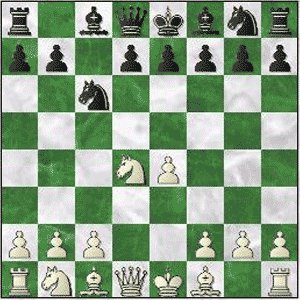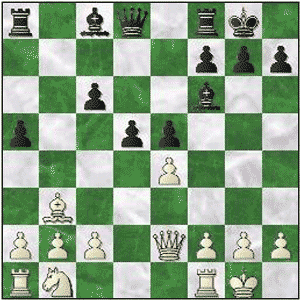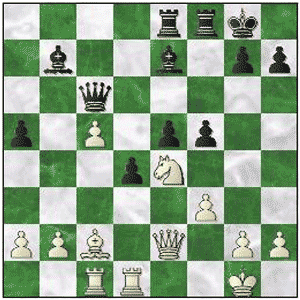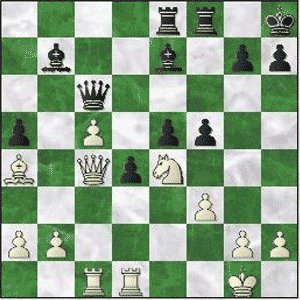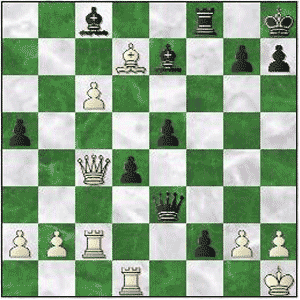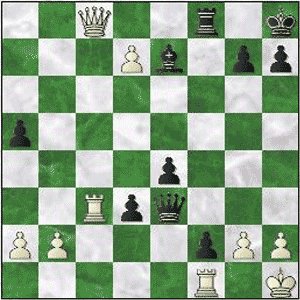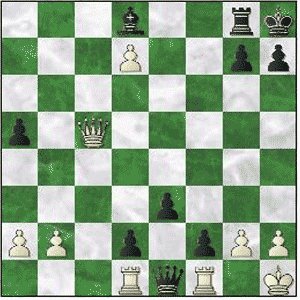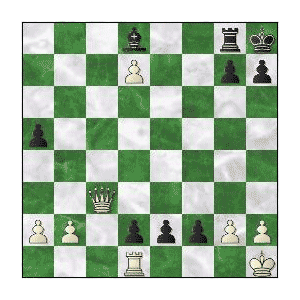| Back to Back Issues Page |
 |
|
LCB, Issue #048 --, Behold the Three Musketeers May 01, 2019 |
Behold the Three MusketeersLapoc Chess Board, Issue #048 -- GOTM #17 learn and play online chess It's 1834, an exciting time for chess. The game is moving from smokey coffeehouses into the mainstream public consciousness. Games are now recorded on an industrial scale and printed in papers for the public to eagerly follow their heroes. This year a series of matches takes place between the two strongest players in the world. The match is followed by the media on a scale never seen before. The man on the street is kept up to speed with the games recorded, analyzed, annotated and published as they are played. The two protagonists, La Bourdonnais and McDonnell, gave the world 85 games of high quality chess with several brilliancies in amongst them. This one features a sharp fight with a rolling pawn mass emerging in the center, giving rise to a remarkable final position. Behold the Three MusketeersMcDonnell, A - La Bourdonnais, L [B32]GotM #17 - London, 1834 1.e4 c5 Black chooses the dynamic Siclian Defense. 2.Nf3 Nc6 3.d4 cxd4 4.Nxd4
Main Starting Position in the 2...Nc6 Sicilian. 4...e5 Loewenthal (Kalashnikov) Variation, the idea is to gain an lead in development. 5.Nxc6 Less popular than the three alternatives given. Maybe McDonnell didn't want to give his opponent the chance to develop quickly as in the most popular 5.Nb5 line. Loewenthal (Kalashnikov) Variation, the idea is to gain an lead in development. (A modern interpretation of 5.Nb5 might go as follows: 5...d6 6.c4 g6 7.Be3 Be6 8.N1c3 a6 9.Na3 Nf6 10.Be2 Bg7 11.Nc2 Rc8 12.Rc1 0-0 13.0-0 Ne7 14.Na3 Nc6 15.Re1 Nd4 16.f3 Qb6 17.Rb1 Nxe2+ 18.Rxe2 Qb4 19.Rd2 Rfd8 20.c5 Qa5 21.Rxd6 Bf8 22.Rxd8 Rxd8 23.Qe2 Bxc5 24.Nc2 Bd4 25.Qe1 b5 26.Nxd4 exd4 27.Bg5 dxc3 28.Qxc3 Qxc3 29.bxc3 Bxa2 30.Bxf6 Rd6 31.Be5 Re6 32.Ra1 Rxe5 33.Rxa2 Re6 34.Kf2 Kf8 35.Ke3 Ke7 36.g4 Kd7 37.f4 Rc6 38.Kd4 Kc7 39.f5 Rc4+ 40.Kd5 Kb6 41.Ra3 a5 42.e5 Ra4 43.Rxa4 1-0 (43) Ivanchuk,V (2715)-Jobava,B (2727) Wijk aan Zee 2015; The more timid 5.Nb3 is harder to convert to a win, but sometimes tenacious play later can make the difference: 5...Nf6 6.Bg5 Be7 7.Bxf6 Bxf6 8.Nc3 0-0 9.Bc4 d6 10.0-0 Be6 11.Nd5 Bg5 12.c3 Rc8 13.Qe2 Kh8 14.Rfd1 Ne7 15.a4 Ng6 16.g3 Bh6 17.Nd2 Bxd2 18.Rxd2 Qg5 19.b3 f5 20.exf5 Bxf5 21.Qe3 Qh5 22.Be2 Bg4 23.Qe4 Bxe2 24.Rxe2 Qh3 25.c4 Rf7 26.Rf1 Rcf8 27.f3 Rf5 28.Ne3 Rg5 29.Rg2 h5 30.Qxb7 h4 31.Ng4 Rxg4 32.fxg4 Rxf1+ 33.Kxf1 Qxg4 34.Qb8+ Kh7 35.Qxd6 Qf3+ 36.Rf2 Qxb3 37.Qd5 hxg3 38.hxg3 Qxg3 39.Qe4 Qg5 40.Ke2 Qh5+ 41.Kd2 Kh8 42.c5 Nf4 43.Kc2 Ne6 44.Kb2 g6 45.c6 Nc5 46.c7 Nxe4 47.c8Q+ Kh7 48.Qb7+ 1-0 (48) Short,N (2677)-Kuderinov,K (2442) Turin 2006; The conservative 5.Nf3 seems to give Black a lead in development but inventive continuations can lead to good outcomes albeit less often than 5.Nb5: 5...Nf6 6.Bc4 Be7 7.0-0 0-0 8.Nc3 d6 9.Bg5 Bg4 10.Bxf6 Bxf6 11.h3 Be6 12.Nd5 Rc8 13.c3 Bg5 14.Qd3 Na5 15.Bb3 a6 16.Rfd1 Nxb3 17.axb3 f5 18.Nxg5 Qxg5 19.exf5 Bxf5 20.Qd2 Qd8 21.Ne3 Be6 22.Qxd6 Bxb3 23.Qxd8 Rcxd8 24.Rxd8 Rxd8 25.Ra3 Bf7 26.Ra5 e4 27.Rc5 Bb3 28.Rc7 b5 29.Nf5 Rd1+ 30.Kh2 Rd2 31.Kg3 g6 32.Nd4 Rxb2 33.Ra7 Bd5 34.Rxa6 e3 35.fxe3 g5 36.Kg4 Rxg2+ 37.Kf5 Rg3 38.e4 Bc4 39.Kf6 h5 40.Ra8+ Kh7 41.Ra7+ Kg8 42.Kg6 Kh8 43.Ra8+ Bg8 44.Nf5 Rd3 45.e5 1-0 (45) Meijers,V (2475)-Solonar,S (2376) Baunatal 2002) 5...bxc6 6.Bc4 A battle for the center ensues. 6...Nf6 7.Bg5 Be7 8.Qe2 d5 9.Bxf6 Bxf6 10.Bb3 0-0 11.0-0 a5
Obliging White to finally relieve the tension. 12.exd5 cxd5 13.Rd1 d4 14.c4 Leaving c2 for his Bishop, he also gets a passed pawn thanks to the pin on the Black Queen. He has however given Black a passed pawn, he must have calculated that this pawn would prove weak. (14.c3 Ba6 (14...Bb7 15.cxd4 exd4 16.Nc3 Rc8 17.Rac1 Bg5 18.Rc2 Re8 19.Qf1 Bc6 20.f4 Bh4 21.Rcd2 Qb6 22.Nd5 Bxd5 23.Bxd5 Bf6 24.g3 g6 25.Kg2 Rc5 26.Bf3 Re3-/+ The d-pawn gives Black the edge, his pieces are becoming increasingly more active than their White counterparts.) 15.Qf3 Rb8 (15...e4 16.Qxe4 Re8 17.Qf5 Qe7 18.h4 g6 19.Qd5 Bb7 20.Qxf7+ Qxf7 21.Bxf7+ Kxf7 22.cxd4 Re2 23.Nc3 Rxb2 24.Rdb1 Rb4 25.a3 Rxb1+ 26.Rxb1 Bc8 27.Nb5 Bxh4 28.Nd6+ Ke6 29.Nc4-+ Black will win as the extra piece is much better than the weak d-pawn.) 16.cxd4 exd4 17.Nc3 d3 18.Rab1 Bd4 19.g3 Rc8 20.Bd5 Bxc3 21.bxc3 Rxc3 22.Kg2-/+ and the advanced passer gives Black a clear advantage.) 14...Qb6 15.Bc2 Bb7 16.Nd2 Building up and winning control of the blockading square, e4. 16...Rae8 17.Ne4 Bd8 18.c5 Qc6 (18...Qxb2 19.Rdb1 Ba6 20.Qd1 Qxa1 (20...Qa3 21.Rb3 Qa4 (21...Qxb3+-) 22.Rh3 Qd7 (22...Qxc2+-) 23.Nf6+ gxf6 24.Rg3+ Kh8 25.Bxh7 (25.Qh5?? d3-+) 25...Be2 26.Qxe2 Rg8 27.Bxg8 Qf5 28.Bxf7+-) 21.Rxa1+-) 19.f3 Be7 20.Rac1 f5
The attack from Black begins as he attempts to get his pawn center rolling. His first objective is to remove the blockade. 21.Qc4+ White
launches a counter as the game moves into a sharp exchange. 21...Kh8 22.Ba4
(22.Nd6 Bxd6 23.Ba4 Qxc5 24.Qxc5 Bxc5 25.Bxe8 Bb6 26.Bb5=/+) 22...Qh6 23.Bxe8 fxe4 Black recognizes that the Knight is a bigger prize than the Bishop. (23...Rxe8? 24.Nd6 Bxd6 25.Qb5 Qe3+ 26.Kh1 Rg8 27.Qxb7 Bb8 28.c6 d3 29.c7 Bxc7 30.Rxc7 Qe2 31.Rg1 h6 32.Rd7 e4 33.Qd5 e3 34.Qxd3 Qxd3 35.Rxd3 Rb8 36.b3 f4 37.g3 fxg3 38.hxg3 a4 39.Rxe3 axb3 40.axb3 Kh7+-) 24.c6 White continues with more complications. 24...exf3 Black follows suit in what is developing into a crazy game. 25.Rc2 Qe3+ 26.Kh1 Bc8 27.Bd7 f2
Black's attack looking menacing. 28.Rf1 Black has gained the initiative as he is posing the more immediate threat. By forcing White into defensive moves he enjoys the suspension of White's attack as he ploughs on with his own. 28...d3 29.Rc3 Bxd7 30.cxd7 But White's single passer is less dangerous than Black's three musketeers. 30...e4 31.Qc8
White trying to turn the tables but Black has a handy resource. 31...Bd8 ends any hopes of a breakthrough with that ploy. 32.Qc4 White will try the same thing again but he is too
slow. Black's attack is far more advanced. 32...Qe1! with a similar idea. 33.Rc1 seems to solve the problem and would have were it not for the rolling pawn mass. 33...d2! 34.Qc5 (34.Rcxe1 fxe1Q 35.g3 Rxf1+ 36.Kg2 d1Q 37.Qb5 Rg1+ 38.Kh3 Rxg3+ 39.hxg3 Qh1#) 34...Rg8 easily sidesteps the problem. 35.Rd1 (35.Rcxe1 fxe1Q 36.Qg1 Qe2-+; 35.Rb1 e3-+) 35...e3
With the deadly threat of 36...e2. 36.Qc3 Qxd1! Pulling the surviving Rook away from his King before the e-pawn advances. 37.Rxd1 e2
All three musketeers have arrived on the seventh and White simply can't stop all of the threats. He resigns. (37...e2 38.Qxd2 (38.Qf3 e1Q+ 39.Rxe1 dxe1Q#; 38.Rb1 f1Q+ 39.Rxf1 exf1Q#; 38.Rxd2 f1Q#; 38.Rg1 fxg1Q+ 39.Kxg1 e1Q#) 38...f1Q+ 39.Rxf1 exf1Q#) 0-1 La Bourdonnais - McDonnell (London, 1834) P.S. If you do not have html based email software and you're using a text only system, you may find that the links are only partially highlighted and may not work. If this is the case, simply copy and paste the entire link into the browser and hit Enter. That should get you where you want to go. Comments, ideas, feedback? I'd be stoked to hear from you. Get in touch See you next month. Ken 
|
| Back to Back Issues Page |
